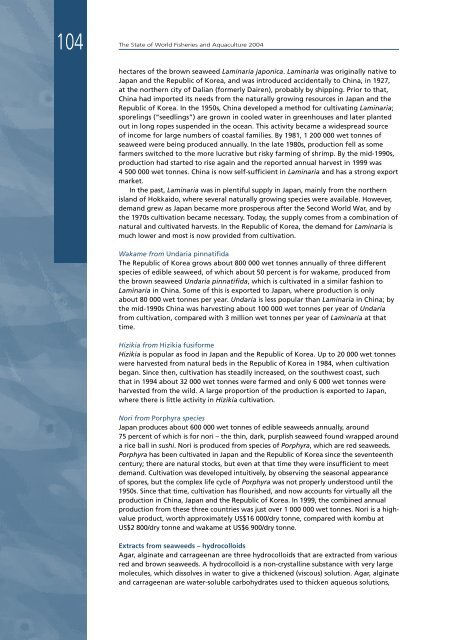State of World Fisheries and Aquaculture 2004 - Library
State of World Fisheries and Aquaculture 2004 - Library
State of World Fisheries and Aquaculture 2004 - Library
You also want an ePaper? Increase the reach of your titles
YUMPU automatically turns print PDFs into web optimized ePapers that Google loves.
104<br />
The <strong>State</strong> <strong>of</strong> <strong>World</strong> <strong>Fisheries</strong> <strong>and</strong> <strong>Aquaculture</strong> <strong>2004</strong><br />
hectares <strong>of</strong> the brown seaweed Laminaria japonica. Laminaria was originally native to<br />
Japan <strong>and</strong> the Republic <strong>of</strong> Korea, <strong>and</strong> was introduced accidentally to China, in 1927,<br />
at the northern city <strong>of</strong> Dalian (formerly Dairen), probably by shipping. Prior to that,<br />
China had imported its needs from the naturally growing resources in Japan <strong>and</strong> the<br />
Republic <strong>of</strong> Korea. In the 1950s, China developed a method for cultivating Laminaria;<br />
sporelings (“seedlings”) are grown in cooled water in greenhouses <strong>and</strong> later planted<br />
out in long ropes suspended in the ocean. This activity became a widespread source<br />
<strong>of</strong> income for large numbers <strong>of</strong> coastal families. By 1981, 1 200 000 wet tonnes <strong>of</strong><br />
seaweed were being produced annually. In the late 1980s, production fell as some<br />
farmers switched to the more lucrative but risky farming <strong>of</strong> shrimp. By the mid-1990s,<br />
production had started to rise again <strong>and</strong> the reported annual harvest in 1999 was<br />
4 500 000 wet tonnes. China is now self-sufficient in Laminaria <strong>and</strong> has a strong export<br />
market.<br />
In the past, Laminaria was in plentiful supply in Japan, mainly from the northern<br />
isl<strong>and</strong> <strong>of</strong> Hokkaido, where several naturally growing species were available. However,<br />
dem<strong>and</strong> grew as Japan became more prosperous after the Second <strong>World</strong> War, <strong>and</strong> by<br />
the 1970s cultivation became necessary. Today, the supply comes from a combination <strong>of</strong><br />
natural <strong>and</strong> cultivated harvests. In the Republic <strong>of</strong> Korea, the dem<strong>and</strong> for Laminaria is<br />
much lower <strong>and</strong> most is now provided from cultivation.<br />
Wakame from Undaria pinnatifida<br />
The Republic <strong>of</strong> Korea grows about 800 000 wet tonnes annually <strong>of</strong> three different<br />
species <strong>of</strong> edible seaweed, <strong>of</strong> which about 50 percent is for wakame, produced from<br />
the brown seaweed Undaria pinnatifida, which is cultivated in a similar fashion to<br />
Laminaria in China. Some <strong>of</strong> this is exported to Japan, where production is only<br />
about 80 000 wet tonnes per year. Undaria is less popular than Laminaria in China; by<br />
the mid-1990s China was harvesting about 100 000 wet tonnes per year <strong>of</strong> Undaria<br />
from cultivation, compared with 3 million wet tonnes per year <strong>of</strong> Laminaria at that<br />
time.<br />
Hizikia from Hizikia fusiforme<br />
Hizikia is popular as food in Japan <strong>and</strong> the Republic <strong>of</strong> Korea. Up to 20 000 wet tonnes<br />
were harvested from natural beds in the Republic <strong>of</strong> Korea in 1984, when cultivation<br />
began. Since then, cultivation has steadily increased, on the southwest coast, such<br />
that in 1994 about 32 000 wet tonnes were farmed <strong>and</strong> only 6 000 wet tonnes were<br />
harvested from the wild. A large proportion <strong>of</strong> the production is exported to Japan,<br />
where there is little activity in Hizikia cultivation.<br />
Nori from Porphyra species<br />
Japan produces about 600 000 wet tonnes <strong>of</strong> edible seaweeds annually, around<br />
75 percent <strong>of</strong> which is for nori – the thin, dark, purplish seaweed found wrapped around<br />
a rice ball in sushi. Nori is produced from species <strong>of</strong> Porphyra, which are red seaweeds.<br />
Porphyra has been cultivated in Japan <strong>and</strong> the Republic <strong>of</strong> Korea since the seventeenth<br />
century; there are natural stocks, but even at that time they were insufficient to meet<br />
dem<strong>and</strong>. Cultivation was developed intuitively, by observing the seasonal appearance<br />
<strong>of</strong> spores, but the complex life cycle <strong>of</strong> Porphyra was not properly understood until the<br />
1950s. Since that time, cultivation has flourished, <strong>and</strong> now accounts for virtually all the<br />
production in China, Japan <strong>and</strong> the Republic <strong>of</strong> Korea. In 1999, the combined annual<br />
production from these three countries was just over 1 000 000 wet tonnes. Nori is a highvalue<br />
product, worth approximately US$16 000/dry tonne, compared with kombu at<br />
US$2 800/dry tonne <strong>and</strong> wakame at US$6 900/dry tonne.<br />
Extracts from seaweeds – hydrocolloids<br />
Agar, alginate <strong>and</strong> carrageenan are three hydrocolloids that are extracted from various<br />
red <strong>and</strong> brown seaweeds. A hydrocolloid is a non-crystalline substance with very large<br />
molecules, which dissolves in water to give a thickened (viscous) solution. Agar, alginate<br />
<strong>and</strong> carrageenan are water-soluble carbohydrates used to thicken aqueous solutions,

















